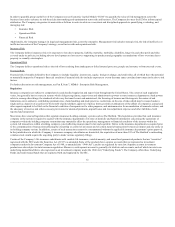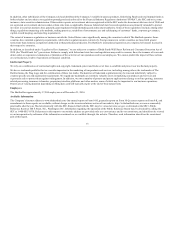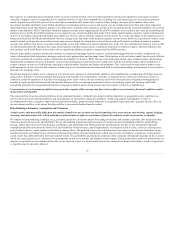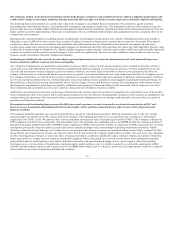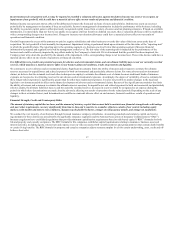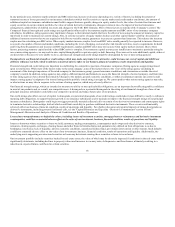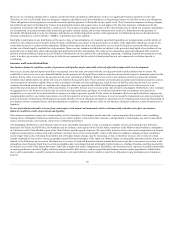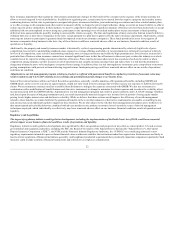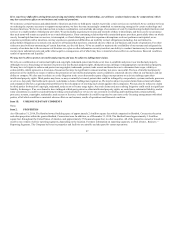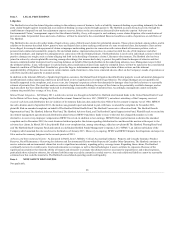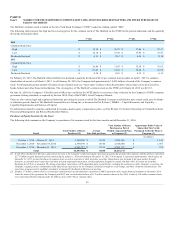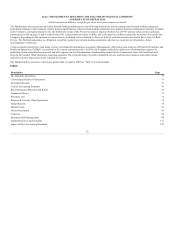The Hartford 2014 Annual Report Download - page 22
Download and view the complete annual report
Please find page 22 of the 2014 The Hartford annual report below. You can navigate through the pages in the report by either clicking on the pages listed below, or by using the keyword search tool below to find specific information within the annual report.
State insurance departments that regulate us often propose premium rate changes for the benefit of the consumer at the expense of the insurer and may not
allow us to reach targeted levels of profitability. In addition to regulating rates, certain states have enacted laws that require a property and casualty insurer
conducting business in that state to participate in assigned risk plans, reinsurance facilities, joint underwriting associations and other residual market plans,
or to offer coverage to all consumers and often restrict an insurer's ability to charge the price it might otherwise charge or restrict an insurer's ability to offer or
enforce specific policy deductibles. In these markets, we may be compelled to underwrite significant amounts of business at lower than desired rates or accept
additional risk not contemplated in our existing rates, participate in the operating losses of residual market plans or pay assessments to fund operating
deficits of state-sponsored funds, possibly leading to unacceptable returns on equity. The laws and regulations of many states also limit an insurer's ability to
withdraw from one or more lines of insurance in the state, except pursuant to a plan that is approved by the state's insurance department. Additionally, certain
states require insurers to participate in guaranty funds for impaired or insolvent insurance companies. These funds periodically assess losses against all
insurance companies doing business in the state. Any of these factors could have a material adverse effect on our business, financial condition, results of
operations or liquidity.
Additionally, the property and casualty insurance market is historically cyclical, experiencing periods characterized by relatively high levels of price
competition, less restrictive underwriting standards, more expansive coverage offerings and relatively low premium rates, followed by periods of relatively
low levels of competition, more selective underwriting standards, more coverage restrictions and relatively high premium rates. Prices tend to increase for a
particular line of business when insurance carriers have incurred significant losses in that line of business in the recent past or when the industry as a whole
commits less of its capital to writing exposures in that line of business. Prices tend to decrease when recent loss experience has been favorable or when
competition among insurance carriers increases. In all of our property and casualty insurance product lines and states, there is a risk that the premium we
charge may ultimately prove to be inadequate as reported losses emerge. In addition, there is a risk that regulatory constraints, price competition or incorrect
pricing assumptions could prevent us from achieving targeted returns. Inadequate pricing could have a material adverse effect on our results of operations
and financial condition.
Adjustments to our risk management program relating to products we offered with guaranteed benefits to emphasize protection of economic value may
result in statutory and U.S. GAAP volatility in our earnings and potentially material charges to net income (loss).
Some of the in-force business within our Talcott Resolution operations, especially variable annuities, offer guaranteed benefits, including GMWB and
GMDB which, in the event of a decline in equity markets, would not only result in lower earnings, but will also increase our exposure to liability for benefit
claims. We use reinsurance structures and have modified benefit features to mitigate the exposure associated with GMDB. We also use reinsurance in
combination with a modification of benefit features and derivative instruments to attempt to minimize the claim exposure and to reduce the volatility of net
income associated with the GMWB liability. Adjustments to our risk management program may result in greater statutory and U.S. GAAP earnings volatility
and, based upon the types of hedging instruments used, can result in potentially material charges to net income (loss) in periods of rising equity market
pricing levels, higher interest rates and declines in volatility. While we believe that these actions would improve the efficiency of our risk management
related to these benefits, we remain liable for the guaranteed benefits in the event that reinsurers or derivative counterparties are unable or unwilling to pay
and, in turn, may need additional capital to support in-force business. We are also subject to the risk that these management procedures prove ineffective or
that unanticipated policyholder behavior, combined with adverse market events, produces economic losses beyond the scope of the risk management
techniques employed, which individually or collectively may have a material adverse effect on our business, financial condition, results of operations and
liquidity.
The impact of regulatory initiatives and legislative developments, including the implementation of the Dodd-Frank Act of 2010, could have a material
adverse impact on our business, financial condition, results of operations and liquidity.
Regulatory initiatives and legislative developments may significantly affect our operations and prospects in ways that we cannot predict. U.S. and overseas
governmental and regulatory authorities, including the SEC, the Board of Governors of the Federal Reserve System (the "Federal Reserve"), the Federal
Deposit Insurance Corporation (“FDIC”), the NYSE and the Financial Industry Regulatory Authority, Inc. (“FINRA”) are considering enhanced or new
regulatory requirements intended to prevent future financial crises or otherwise stabilize the institutions under their supervision. Such measures are likely to
lead to stricter regulation of financial institutions generally, and heightened prudential requirements for systemically important companies in particular. Such
measures could include taxation of financial transactions and restrictions on employee compensation.
22


